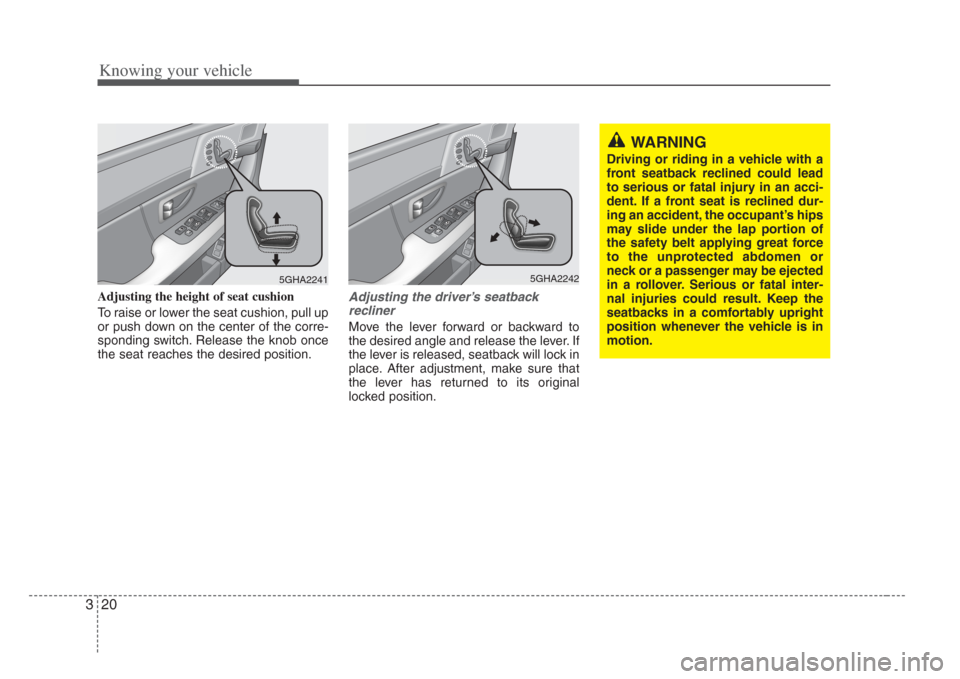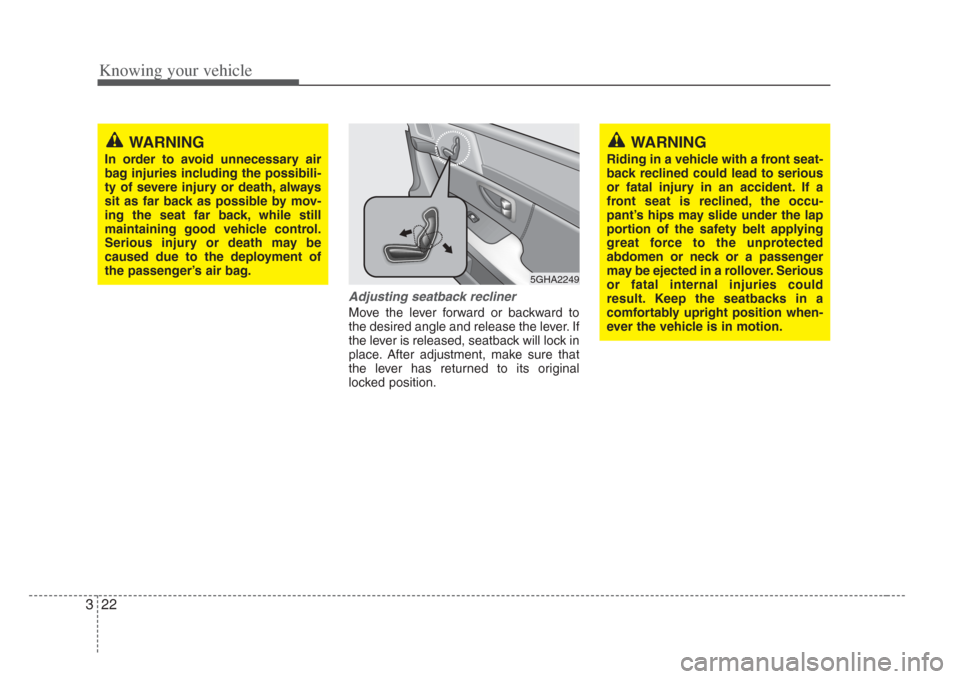Page 27 of 283
317
Knowing your vehicle
Driver’s seat
➀
Seat adjustment, forward / back-
ward/height
➁Seatback recliner
➂Seat heater / ventilator switch*
➃Lumbar support
➄Driver position memory system*
■ Headrest adjustment (headrest
cannot be adjusted by a switch)
Front passenger seat
➅
Seat adjustment, forward / backward
\bSeatback recliner
➇Seat heater / ventilator switch*
■ Headrest adjustment (headrest
cannot be adjusted by a switch)
Rear seat
➈
Seat heater switch (left)*
\fSeat heater switch (right)*
* : if equipped
SEATS
STOPSTOP
OGH026012N
Page 28 of 283

Knowing your vehicle
183
For a seating position more comfortable
to the driver and front passenger, adjust
the seat forward, backward, up and
down.
WARNING
• Loose objects in the driver’s foot
area could interfere with the oper-
ation of the foot pedal s,possibly
caus ing an accident. Loos e
objects might interfere with the
s eat slide mechanis m. Do not
place anything under the front
seats.
• The power s eats are operable
with the ignition OFF.
Therefore, children should never
be left unattended in the car.
WARNING- Driver’ s seat
• Never attempt to adjus t the seat
while the vehicle is moving. This
could res ult in loss of control, and
an accident caus ing death,seri-
ous injury, or property damage.
• Do not allow anything to interfere with the normal pos ition of the
s eatback. Storing items against a
s eatback or in any other way inter-
fering with proper locking of a
s eatback could res ult in serious
or fatal injury in a s udden stop or
collis ion.
(Continued)
(Continued)
• Always drive and ride with yourseatback upright and the lap por-
tion of the safety belt, or lap belt,
snug and low across the hips.
This pos ition puts your safety
belts in the best position to pro-
tect you in case of an accident.
• In order to avoid unnece ssary air
bag injuries including the po ssi-
bility of severe injury or death,
always sit as far back as possible
from the steering wheel while still
being able to maintain comfort-
able control of your vehicle.
• The Canadian Motor Vehicle Safety Standards (CMVSS) rec-
ommends that the driver sit at
least 250 mm (10 inches) away
from the steering wheel to avoid
the risk of serious injury or death
due to the deployment of the dri-
ver’ s air bag.
CAUTION
• Power seats are driven by electric
motor. Stop operating when the adjustment is completed.
Excessive operation may damagethe electrical equipment.
• When in operation, the power seats consume large amounts ofelectrical power. To preventunnecessary charging s ystem
drain, don’t adjus t the power
s eats longer than necessary
while the engine is not running.
• Do not operate two or more power seat control buttons at the sametime. Doing so may res ult in
power seat motor or electrical
component malfunction.
Page 29 of 283
319
Knowing your vehicle
Driver’s seat adjustment
Forward/backward position and
height adjustment
Adjusting the seat forward and backward
Push the control button forward or back-
ward to move the seat to the desired
position. Release the knob and the seat
will lock in the selected position.
Adjust the seat before driving, and make
sure the seat is locked securely by trying
to move forward and backward without
using the control knob. If the seat moves,
it is not locked properly. Adjusting front height of seat cushion
Move the front portion of the control knob
up to raise or down to lower the front part
of the seat cushion.
Adjusting rear height of seat cushion
Move the rear portion of the control knob
up to raise or down to lower the rear part
of the seat cushion.
5GHA22385GHA22395GHA2240
Page 30 of 283

Knowing your vehicle
203
WARNING
Driving or riding in a vehicle with a
front seatback reclined could lead
to serious or fatal injury in an acci-
dent. If a front seat is reclined dur-
ing an accident, the occupant’ s hips
may slide under the lap portion of
the safety belt applying great force
to the unprotected abdomen or
neck or a passenger may be ejected
in a rollover. Serious or fatal inter-
nal injuries could result. Keep the
seatbacks in a comfortably upright
position whenever the vehicle i s in
motion.
Adjusting the height of seat cushion
To raise or lower the seat cushion, pull up
or push down on the center of the corre-
sponding switch. Release the knob once
the seat reaches the desired position.Adjusting the driver’ s seatback
recliner
Move the lever forward or backward to
the desired angle and release the lever. If
the lever is released, seatback will lock in
place. After adjustment, make sure that
the lever has returned to its original
locked position.
5GHA22415GHA2242
Page 32 of 283

Knowing your vehicle
223
Adjusting seatback recliner
Move the lever forward or backward to
the desired angle and release the lever. If
the lever is released, seatback will lock in
place. After adjustment, make sure that
the lever has returned to its original
locked position.
WARNING
In order to avoid unnecessary air
bag injuries including the po ssibili-
ty of severe injury or death, alway s
sit as far back as possible by mov-
ing the seat far back, while still
maintaining good vehicle control.
Serious injury or death may be
caused due to the deployment of
the passenger’ s air bag.
5GHA2249
WARNING
Riding in a vehicle with a front seat-
back reclined could lead to serious
or fatal injury in an accident. If a
front seat is reclined, the occu-
pant’ s hips may slide under the lap
portion of the safety belt applying
great force to the unprotected
abdomen or neck or a passenger
may be ejected in a rollover. Serious
or fatal internal injuries could
res ult. Keep the s eatbacks in a
comfortably upright po sition when-
ever the vehicle i s in motion.
Page 34 of 283

Knowing your vehicle
243
Headrest adjustment
Adjusting forward and backward
The headrest may be adjusted forward to
three different positions by pulling the
headrest forward. To adjust the headrest
backward, pull it fully forward to the far-
thest position and release it. Adjust the
headrest so that it properly supports the
head and neck.
Adjusting the height up and down
The headrest not only provides comfort
for the driver and passengers, but also
helps protect the head and neck in the
event of a collision.
To raise the headrest, pull it up to the
desired position (
➀). To lower the head-
rest, push and hold the release button
(
➁) on the headrest support and lower
the headrest to the desired position (
➂).
For best protection, adjust the headrest
so its center is as high as your ears. Also
adjust the headrest so its distance from
the head is as wide as your fist.
1GHA2245
WARNING
Pa ssenger s should us e extreme
caution when using seat warmers
due to the possibility of excess
heating or burn s. In particular, the
following types of passengers
should exercise extreme care:
1. Infants, children, elderly or di s-
abled per sons, or hospital outpa-
tients
2. Per sons with sensitive skin or
those that burn ea sily
3. Fatigued individual s
4. Intoxicated individual s
5. Individuals taking medication
that can caus e drowsiness or
sleepiness ( sleeping pills, cold
tablets, etc.)
1GHA2246
Page 36 of 283

Knowing your vehicle
263
Headrest adjustment
Adjusting the height up and down
The headrest not only provides comfort
for the rear passengers, but also helps
protect the head and neck in the event of
a collision.
For best protection, adjust the headrest
so its center is as high as your ears. Also
adjust the headrest so its distance from
the head is as wide as your fist.
To raise the headrest, pull it up to the
desired position (
➀). To lower the head-
rest, push and hold the release button
(
➁) on the headrest support and lower
the headrest to the desired position (
➂).
WARNING
Pa ssenger s should us e extreme
caution when using seat warmers
due to the possibility of excess
heating or burn s. In particular, the
following types of passengers
should exercise extreme care:
1. Infants, children, elderly or di s-
abled per sons, or hospital outpa-
tients
2. Per sons with sensitive skin or
those that burn ea sily
3. Fatigued individual s
4. Intoxicated individual s
5. Individuals taking medication
that can caus e drowsiness or
sleepiness ( sleeping pills, cold
tablets, etc.)
1GHA2254
CAUTION
• When cleaning the seats, do not
use an organic solvent such as
thinner, benzene, alcohol and gasoline. Doing so may damage
the surface of the heater or seats.
• To prevent overheating the seat
warmer, do not place blanket s,
cushions or seat cover s on the
seats while the seat warmer is in operation.
• Do not place heavy or s harp
objects on seats equipped with seat warmer s. Damage to the
seat warming components could occur.
Page 47 of 283

337
Knowing your vehicle
5. Adjust the shoulder anchor position toyour size. To raise the anchor position,
push the anchor up (
➀). To lower the
anchor position, press the button (
➁)
and slide the anchor down (
➂). After
adjustment, make sure the anchor is
locked in position.
To unfasten the front lap/shoulder belt:
Press the release button on the buckle
and allow the belt to slowly retract.
MMSA30265GHN3900
WARNING
• The height adju ster must be in
the locked pos ition when the
vehicle is moving.
• The misadjustment of height of the shoulder belt could reduce
the effectiveness of the seat belt
in a crash.
WARNING
• The seatbacks should always
remain in a comfortable, upright
position while the vehicle is in
motion. The safety belt system
will provide the most protection
with the seatbacks in an upright
position.
• Never wear the shoulder portion of the safety belt under the out-
side arm or behind the back.
• Never wear the shoulder portion of the safety belt across the neck
or face.
• Wear the lap portion of the safety
belt as low on the hips a s possi-
ble. Be sure the lap belt fits snug-
ly around the hip s. Never wear the
lap belt over your wai st.
(Continued)